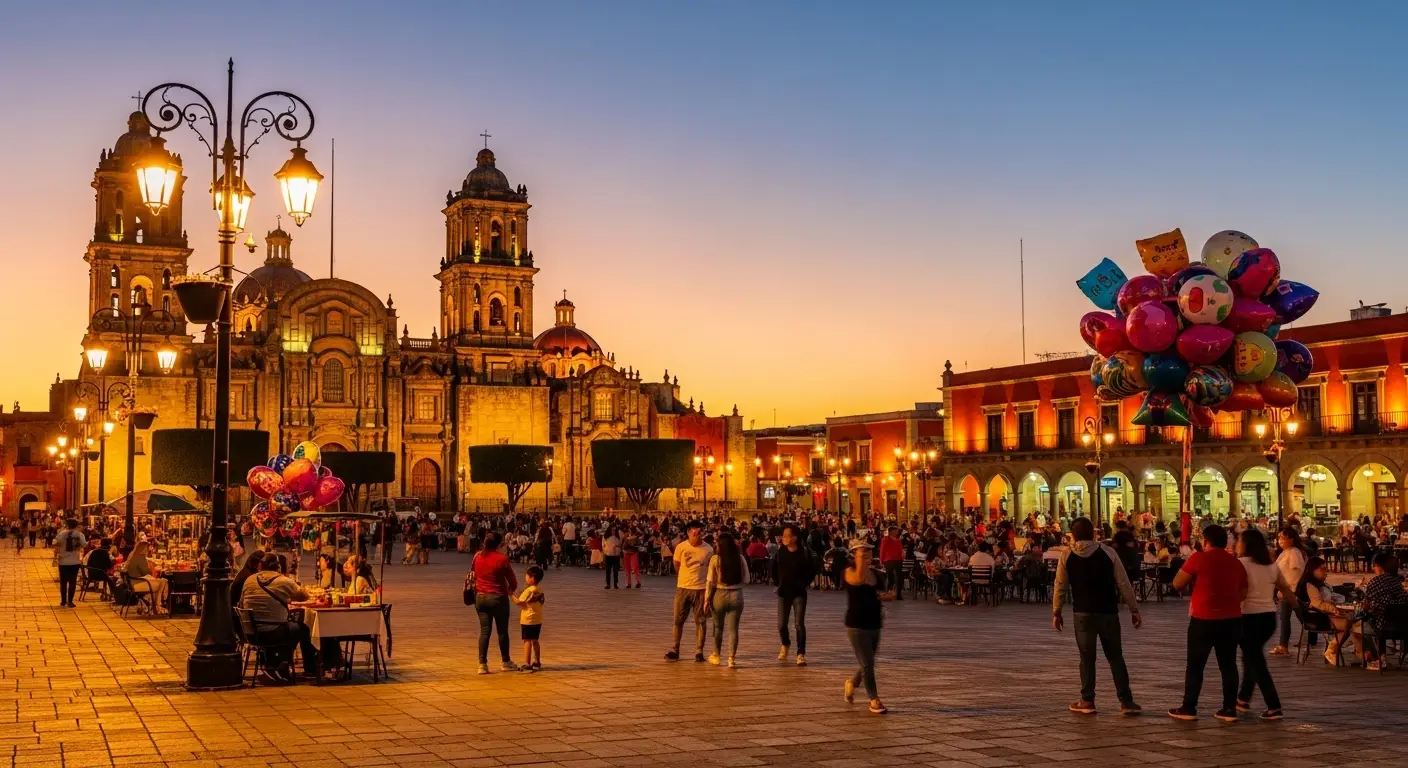The Straight Answer: Is Oaxaca Safe for American Tourists?
Yes, Oaxaca is generally safe for American tourists. I’ve spent time in Oaxaca City and felt safe walking through the historic center and exploring neighborhoods even at night. Like any destination worth visiting, it requires awareness and common sense.
What’s Really Happening in Oaxaca This Year
Recent Safety Trends and 2026 Updates
The safety landscape in Oaxaca has remained stable throughout 2025. During my last visit, I noticed increased police presence around major tourist areas, particularly near the zócalo. There has been a slight uptick in petty crime during high tourist seasons like Day of the Dead celebrations.
Crime Statistics That Tell the Real Story
Violent crime in Oaxaca remains significantly lower than in border states like Tijuana or Michoacan. When you look at crime rates per capita, Oaxaca City compares favorably to many cities in Mexico and even some U.S. metropolitan areas. Zero American tourists were victims of homicide in the state of Oaxaca in recent years.
Moving from statistics to policy, let’s examine what the U.S. government actually says about visiting.
Best Things To Do In Puerto Escondido Oaxaca
Breaking Down the State Department Advisory for Americans
What “Exercise Increased Caution” Actually Means
The U.S. State Department lists Oaxaca at Level 2, which means “exercise increased caution.” Here’s the context: Level 2 is the same advisory level as France, Germany, and the United Kingdom.
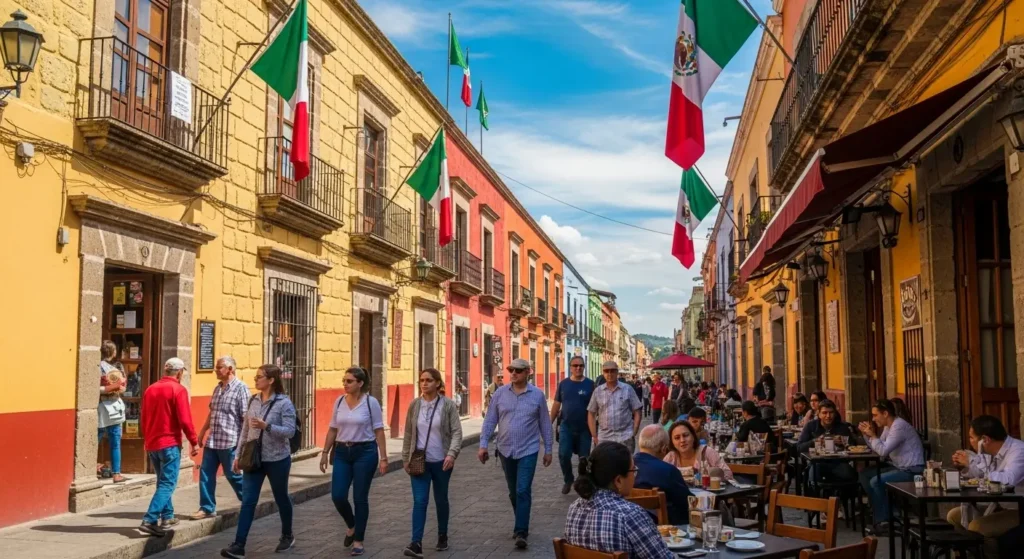
The advisory exists primarily because the government has limited ability to help citizens in certain areas of the state, particularly outside city limits.
How Oaxaca Compares to Popular European Destinations
If you’re comfortable visiting Paris or Berlin, the advisory level suggests you should be equally comfortable visiting Oaxaca. We’ve been conditioned to see “Mexico” and immediately think danger, while “Europe” sounds safe. I’ve felt more on edge in parts of Barcelona than I ever did exploring Oaxaca.
Why the Advisory Exists (And What It Doesn’t Tell You)
The travel advisories are broad and cover the entire state, including remote rural areas where few tourists venture. The coast of Oaxaca includes regions with travel restrictions that have nothing to do with the places you’ll likely visit. What the advisory doesn’t tell you is that millions of people visit Oaxaca each year without incident.
Now that we understand the official warnings, let’s address why Americans worry in the first place.
Best Things to Do in Huatulco Oaxaca
Why Americans Worry About Oaxaca (Media vs. Reality)
Is Oaxaca safe from cartels?
The Mexican cartels operating in border regions have virtually no interest in tourist areas of Oaxaca. Their activity in Mexico focuses on drug trafficking routes, not colonial cities filled with mezcal bars and art galleries. During my entire time in Oaxaca, I never felt the presence of organized crime.
What Netflix Got Wrong About Mexican Safety
Shows like “Narcos: Mexico” have created this mental image that cartel violence is everywhere. But Oaxaca exists in a completely different reality. It’s a cultural hub known for indigenous traditions, incredible food, and artisan crafts—not drug wars.
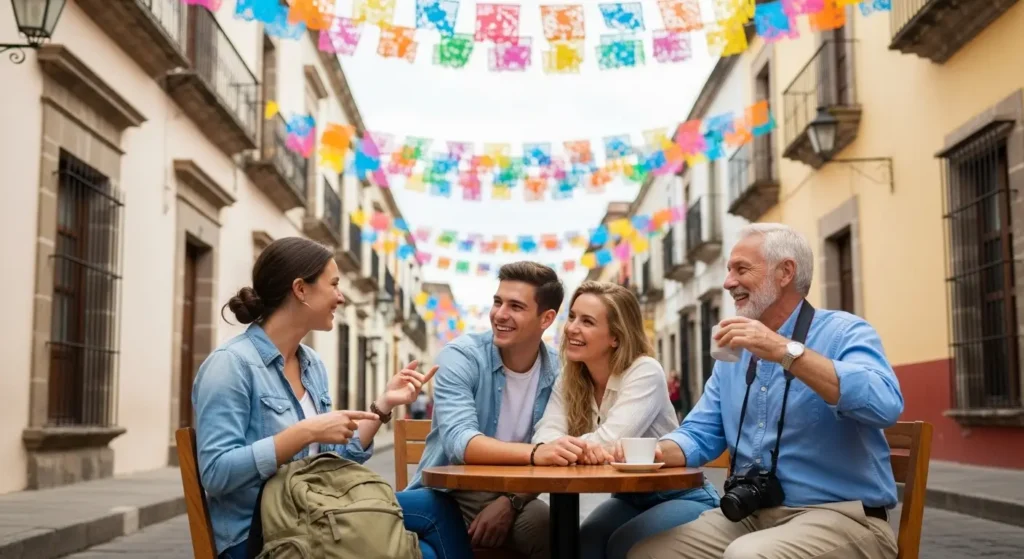
How Oaxaca Is Different from Border States
The contrast between Oaxaca and border cities is night and day. While places near the U.S. border deal with complex security issues, Oaxaca’s challenges are more typical of any developing destination. It’s over 800 miles from Texas, tucked in southern Mexico, with its own distinct culture.
With fears addressed, let’s look at actual numbers that matter.
Oaxaca vs. Your Hometown: A Data-Driven Comparison
Crime Rates: Oaxaca City vs. Major U.S. Cities
When you actually look at safety conditions using comparable data, Oaxaca City’s crime rate sits below that of cities like Baltimore, St. Louis, and Detroit. An expat who’s lived in Oaxaca for five years told me she feels safer walking around the city at night than in her former home of Miami.
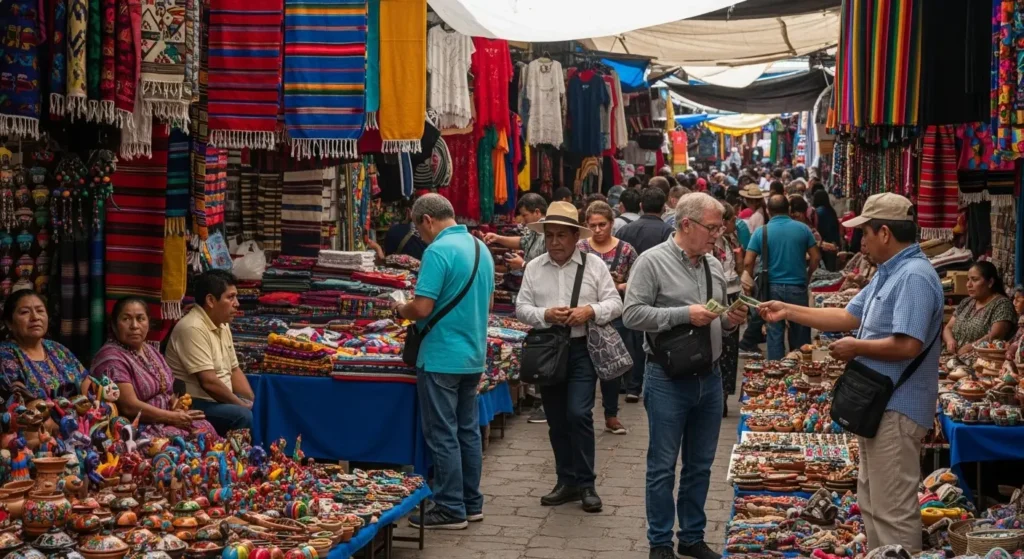
What the Numbers Mean for Your Trip
What matters more than overall crime rates is the type of crime tourists typically encounter. In Oaxaca, you’re far more likely to deal with a pickpocket than anything violent. That’s manageable with basic precautions—don’t flash expensive jewelry and keep your phone secure.
Zero American Tourist Homicides: The Statistic Nobody Talks About
American tourists are not being targeted or harmed in violent ways in Oaxaca. The State Department tracks these incidents carefully, and the numbers show that visiting Oaxaca as an American tourist carries minimal risk of serious harm.
Understanding the data is one thing, but what about your personal experience as an American?
Best Time to Visit Oaxaca Mexico
The American Experience: What Makes You Stand Out
Looking and Acting Like a Tourist (And Why That Matters)
Most Americans stand out in Oaxaca, not just because of physical appearance but because of how we dress and carry ourselves. The good news is that Oaxaca’s economy depends heavily on tourism, so being identified as a traveler generally means people want to help you.
The Language Barrier: Will You Be Fine Without Spanish?
I traveled to Oaxaca with extremely basic Spanish and managed perfectly well. In major tourist areas and better restaurants around the city, you’ll find English speakers. Learning a few key phrases shows respect for the local culture and makes your experience richer.

Cultural Differences That Keep You Safer
Oaxaca feels community-oriented compared to many U.S. cities. People look out for each other. This cultural emphasis on community creates an environment where tourists are generally protected rather than targeted.
Knowing the culture helps, but you also need to know where to go.
Where to Stay and Where to Avoid: A Neighborhood Guide
The Safest Areas for American Visitors
Centro Histórico is your safest bet, with constant foot traffic and police presence. Jalatlaco is a charming neighborhood just east of the centro that’s quieter but still feels secure during daylight hours. Reforma offers a more local experience with better prices on accommodations.
Neighborhoods That Deserve Extra Caution
Central de Abastos, the massive main market, deserves special mention. I visited with a local friend who warned me to leave my camera at the hotel. The market itself isn’t dangerous, but the crowds and chaos create perfect conditions for pickpockets. Go during morning hours and keep bags secured in front of you.
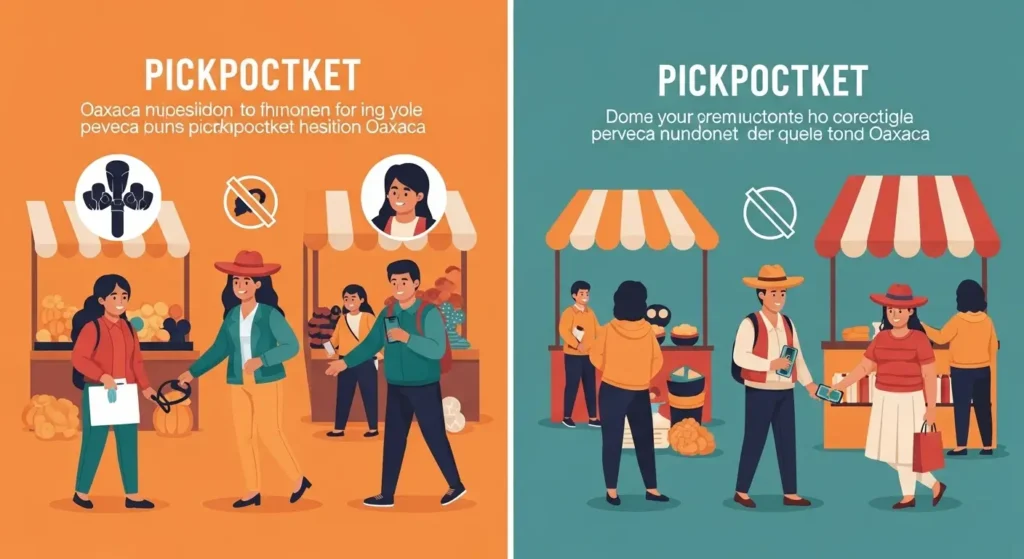
Santa Rosa and surrounding neighborhoods require extra awareness, especially at night. These aren’t tourist zones, and you’ll stand out more. Cerro del Fortín offers stunning city views, but locals specifically warned me against walking there. Several travelers have reported uncomfortable encounters on the trails, especially at night. Take a taxi to the top during the day if you want to see the views.
San Felipe and areas beyond the well-traveled tourist corridors become less predictable. Stick to neighborhoods where you see other travelers and established businesses. Areas outside the city limits should only be traveled during daylight with clear directions.
Coastal Oaxaca: Puerto Escondido and Huatulco Safety
I spent four days in Puerto Escondido and found it relaxed and welcoming. Puerto Escondido has typical beach town issues—petty theft from unattended belongings—but violent crime is rare. Huatulco is even more developed and resort-oriented with higher security.
Beyond official guides, real experiences tell the fuller story.
Real Stories from American Travelers
What Solo Female Travelers Are Saying
I connected with several solo female travelers in Oaxaca, and their experiences were overwhelmingly positive. One woman from Colorado told me Oaxaca was where she felt most comfortable during two weeks of travel to Mexico. The consensus was that Oaxaca is safe for solo female travelers who exercise reasonable awareness.
Families Who Visited and Felt Comfortable
Families with children are everywhere in Oaxaca. A family from Oregon told me they’d initially worried about bringing their two young children but found Oaxaca easier to navigate than many U.S. cities in Mexico. Their main safety concern ended up being the uneven sidewalks, not crime.
Long-Term Expats Share Their Honest Take
One expat from California has lived in Oaxaca for seven years and has never experienced violent crime. She’s had a phone stolen once but nothing that made her question her decision to live in Oaxaca. Her perspective was that you need the same street smarts you’d use in Los Angeles or Chicago.
Stories are valuable, but practical advice is essential.
Practical Safety Tips That Actually Work
Getting Around: Taxis, Buses, and Transportation
Taxis in Oaxaca are your safest transportation option. Use the official white and red taxis you’ll find at designated stands near the zócalo. Uber operates in Oaxaca but with limited availability compared to Mexico City. DiDi is another app option that’s growing in popularity. Expect to pay 40-60 pesos ($2-3 USD) for most trips within the centro.

I made it a rule to always take a taxi after dark, even for distances that seemed walkable. Your hotel can call trusted drivers—I had the front desk arrange my rides, which added an extra layer of security. Walking is perfectly safe in major tourist areas during the day, and I covered miles on foot exploring side streets.
Colectivos and local buses are how residents get around. While they’re cheap, the US State Department recommends against tourists using public buses. I tried them once during peak afternoon hours and felt fine, but I wouldn’t rely on them as my primary way to get around the city.
ATM Safety and Handling Money
Always use ATMs inside banks during business hours when possible. I used the Banamex and HSBC machines in the centro and never had issues. The added security and foot traffic inside banks reduce the risk of card skimming or robbery after withdrawal.

Carry smaller bills for day-to-day expenses. Street food vendors, taxi drivers, and small shops often can’t make change for 500-peso notes. This also means you’re not flashing large amounts of cash in markets. Never count money in public—I saw tourists do this after exchanging currency, making themselves obvious targets.
Is Oaxaca Safe To Walk at Night ?
Oaxaca’s nightlife revolves around mezcal bars and rooftop restaurants that stay open late. The mezcal scene is part of what makes this destination special—you’ll find tasting rooms and palenques throughout the centro. I spent several evenings hopping between mezcal bars near the zócalo and always felt safe in these well-lit, busy areas.
The streets around the zócalo remain populated until midnight, creating natural security. However, I always took a taxi back to my hotel after enjoying mezcal tastings. The bars and restaurants are concentrated enough that you can walk between venues, but getting home safely means using registered transportation.
Travel in groups when possible, especially when visiting mezcal bars in quieter neighborhoods. Some of the best mezcal experiences are in residential areas where foot traffic drops after 10 PM.
Day Trips and Exploring Beyond the City
Monte Albán, the ancient Zapotec ruins, is perfectly safe to visit during daylight hours with organized tours. I went mid-morning and felt completely secure with dozens of other tourists around. Hierve el Agua, the petrified waterfalls, requires a longer day trip but is considered safe when traveling with reputable tour operators. The drive takes you through beautiful mountain villages where locals are welcoming.
Teotitlán del Valle and other artisan villages are among the safe areas you can explore independently. I visited a weaving cooperative and wandered the streets freely. If you’re renting a car, stick to main highways during daylight hours and always have your hotel staff recommend routes.
Beyond general tips, watch out for these specific issues.
Common Scams and How to Spot Them
The Fake Police Officer Scenario
Real police officers in Mexico will not ask to inspect your wallet or cash. If someone approaches claiming to be police, politely but firmly ask to go to the nearest police station. Legitimate officers will agree; scammers will back off.
Overcharging and Tourist Traps
For taxis, establish the fare before getting in. At markets, expect to negotiate, but know rough price ranges. If something seems absurdly expensive, walk away.
Distraction Techniques at Markets
Keep your bags zipped and in front of you in crowded areas. I use a cross-body bag with the opening against my body, making it nearly impossible for someone to access without me noticing. Leave expensive jewelry at your hotel—you don’t need it for exploring markets.
The classic distraction involves someone bumping into you or dropping something while an accomplice reaches for your phone or wallet. I witnessed this attempted at the Benito Juárez Market when someone “accidentally” knocked over fruit near tourists. Stay alert, keep your valuables secure, and don’t be afraid to firmly say “no” to overly aggressive vendors.
Street food is one of Oaxaca’s greatest pleasures, and eating at popular stalls is generally safe. Choose vendors with high turnover and locals in line. I ate street food almost daily without getting sick by following the basic rule: eat where you see Oaxacan families eating.
Preparation before you leave makes everything easier.
What Americans Need Before They Go
U.S. Embassy Contact Information
The consular agent in Oaxaca is located at Macedonio Alcalá 407, Interior 20. For serious emergencies, contact the U.S. Embassy in Mexico City at +52 55 8526 2561.
Smart Traveler Enrollment Program (STEP)
Enroll in the Smart Traveler Enrollment Program before going to Oaxaca. It takes five minutes and connects you with the nearest embassy in case of an emergency.
Travel Insurance Recommendations for U.S. Citizens
Travel insurance isn’t required for international travel to Mexico, but it’s incredibly valuable. World Nomads and SafetyWing are popular options among travelers, covering medical emergencies that your U.S. health insurance won’t cover abroad. A solid travel insurance policy costs roughly $50-100 for a week-long trip to Mexico.
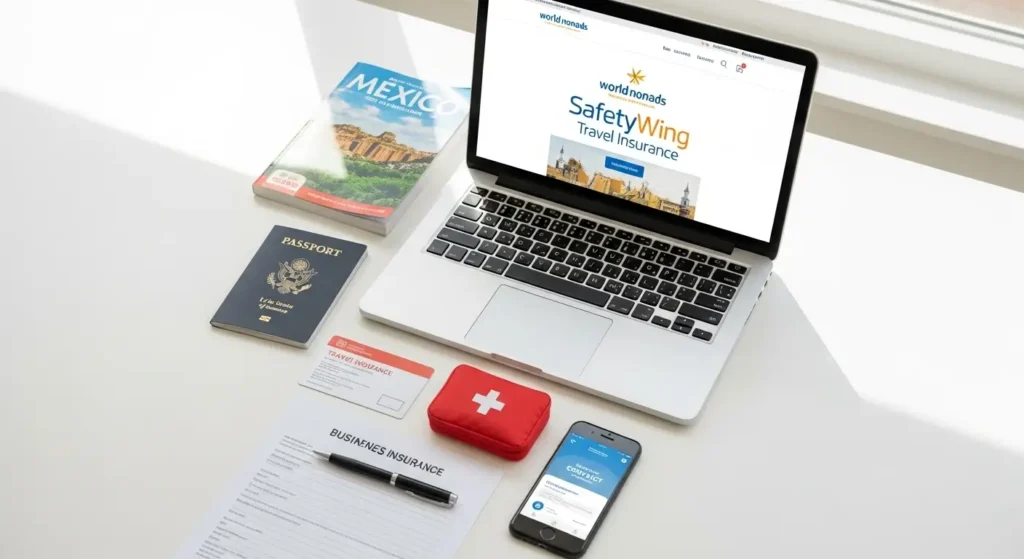
Medical care in Oaxaca is affordable, but serious emergencies might require evacuation to Mexico City. Without insurance, evacuation costs can run into tens of thousands of dollars. I always purchase travel insurance before going to Oaxaca—it’s inexpensive peace of mind.
Medical Care and Emergency Resources
Healthcare quality in Oaxaca City is better than many Americans expect. For serious emergencies, dial 911—yes, the same number as in the United States.
Not all safety concerns are crime-related.
When Safety Concerns Are Valid
Political Protests and Demonstrations
Oaxaca has a history of political activism, and protests are not uncommon. The protests I witnessed were organized and peaceful. As a tourist, observe from a distance or avoid the area entirely.
Natural Disasters and Weather Risks
Oaxaca sits in an earthquake-prone region, and tremors are relatively common. Hurricane season along the coast runs roughly June through November. The bigger weather issue is simply the heat and sun intensity.
Areas with Current Travel Restrictions
Certain areas of the state have travel restrictions in remote regions tourists rarely visit. Highway 200 along the coast sometimes has checkpoints. These restrictions don’t impact the typical tourist experience.
Context matters when choosing your destination.
How Oaxaca Compares to Other Parts of Mexico
Oaxaca vs. Mexico City Safety
Mexico City is massive and requires constant vigilance. Oaxaca feels manageable and intimate by comparison. In Mexico City, you’re always navigating crowds. In Oaxaca, you can relax more.
Why Oaxaca Feels Different from Cancún
Cancún and the Riviera Maya are purpose-built tourist zones with heavy security. Oaxaca offers a more authentic Mexican experience. I actually felt safer in Oaxaca than in some parts of Cancún’s tourist zone.
The Reality of Small-Town Oaxaca
Smaller towns surrounding Oaxaca City are exceptionally welcoming. I visited several artisan villages and felt like I was in a different era. These towns rely on tourism but haven’t been overrun by it.
With all this information, here’s how to use it.
Making Your Trip Safer: Action Steps
Before You Leave Home
Create digital copies of your passport and travel insurance documents. Share your itinerary with someone back home. Research your hotel location before booking.
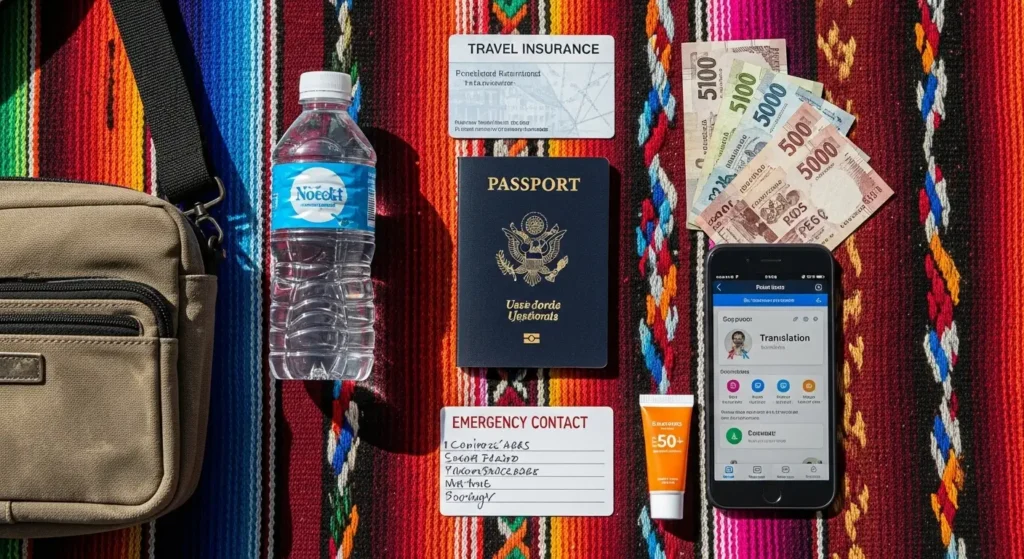
Your First Day in Oaxaca
Walk the main streets near your hotel during daylight to get your bearings. Establish relationships with your hotel staff. Do a practice run for any important locations.
Daily Habits That Reduce Risk
Check in with someone daily. Vary your schedule and routes when possible. Stay moderately sober. Trust your instincts—if a situation feels wrong, extract yourself.
Now for the most common questions.
Frequently Asked Questions
Is Oaxaca safe from cartels?
Yes, Oaxaca is one of the safer states when it comes to organized crime. The cartel violence is concentrated in border states, not in cultural destinations like Oaxaca City.
Is Oaxaca City safe at night?
The centro remains safe and active at night with restaurants open late. However, always take a taxi back to your hotel rather than walking through quiet streets after dark.
Can Americans drink the water in Oaxaca?
No, always drink bottled water in Oaxaca. It’s available everywhere and incredibly cheap. Most restaurants serve purified water.
Is Oaxaca safe for solo female travelers?
Yes, many solo female travelers visit Oaxaca and feel comfortable with basic safety precautions. Stay in well-lit areas and use registered taxis at night.
Is Oaxaca safer than other Mexican destinations?
Oaxaca is considered safe and is one of the safer states in Mexico for tourists. It feels safer than some beach party destinations, though places like Mérida have similarly low crime rates.
What is the safest part of Mexico for American tourists?
Besides Oaxaca, safer states in Mexico include Yucatán, Baja California, and Querétaro. These areas have strong tourism infrastructure and low violent crime rates.
Is Oaxaca worth visiting despite safety concerns?
Absolutely. Oaxaca is one of Mexico’s cultural treasures with incredible food, traditions, and world-class mezcal. The safety concerns are manageable with reasonable precautions.
Do I need to speak Spanish to be safe in Oaxaca?
No, but basic phrases help. Many people in popular tourist areas speak some English. Knowing how to ask for help makes your experience smoother.
Final Verdict: Should Americans Visit Oaxaca in 2026?
After spending considerable time in Oaxaca across multiple visits, my answer is absolutely yes. This destination offers cultural richness, incredible cuisine, and authentic experiences you won’t find in resort towns. The local culture welcomes visitors, and the food scene alone justifies the journey.
Is Oaxaca perfectly safe? No place is. You’ll need basic safety precautions—use registered taxis, keep valuables secure, and stay aware in crowded markets. These are the same common-sense measures you’d take in any major city, whether you’re in Chicago, Rome, or exploring Oaxaca.
The question isn’t whether Oaxaca is safe enough to visit. The real question is: what are you waiting for?
